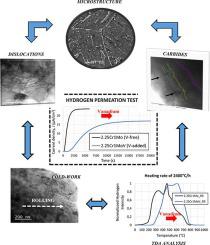当前位置:
X-MOL 学术
›
Journal of Theoretical and Applied Mechanics
›
论文详情
Our official English website, www.x-mol.net, welcomes your
feedback! (Note: you will need to create a separate account there.)
Evaluation of hydrogen trapping and diffusion in two cold worked CrMo(V) Steel grades by means of the electrochemical hydrogen permeation technique
Theoretical and Applied Fracture Mechanics ( IF 5.0 ) Pub Date : 2020-12-01 , DOI: 10.1016/j.tafmec.2020.102771 L.B. Peral , Z. Amghouz , C. Colombo , I. Fernández-Pariente
Theoretical and Applied Fracture Mechanics ( IF 5.0 ) Pub Date : 2020-12-01 , DOI: 10.1016/j.tafmec.2020.102771 L.B. Peral , Z. Amghouz , C. Colombo , I. Fernández-Pariente

|
Abstract Hydrogen diffusion kinetics, which is influenced by the hydrogen trapping and de-trapping phenomena within the steel microstructure, plays an important role on the behaviour of steel components under hydrogen environments. Hence, the complex interaction between hydrogen atoms and steel microstructure must be analyzed in order to discuss the impact of hydrogen on the structural damage. Quenched and tempered low-alloy ferritic steels from the Cr-Mo family, with and without vanadium, have been subjected to different plastic deformation ratios by cold rolling. Dislocation densities have been determined by the analysis of the peak broadening on X-Ray diffractograms. Hydrogen diffusion kinetics was characterized by means of hydrogen permeation transients. In addition, binding energies between hydrogen atoms and microstructure were also determined using thermal desorption analysis (TDA). The analysis of the results highlights the influence of dislocations density and vanadium carbides on the hydrogen diffusion kinetics. In the 2.25Cr1Mo steel grade, hydrogen apparent diffusion coefficient decreased after the cold-work due to the increase in the density of traps (mainly related to dislocation core, ΔETL = 55–60 kJ/mol). Nevertheless, after 10% of plastic deformation, apparent diffusion coefficient ‘saturates’ according to the ‘plateau’ determined in the dislocation density evolution at higher deformation levels. Due to the vanadium addition (+0.31%), hydrogen apparent diffusion coefficient was notably reduced (compared to that obtained in the V-free steel grade). Hydrogen trapping and diffusion are the result of the interplay between vanadium carbides (ΔETL = 35 kJ/mol) and dislocation core.
中文翻译:

利用电化学氢渗透技术评估两种冷加工 CrMo(V) 钢种中氢的俘获和扩散
摘要 氢扩散动力学受钢微观结构内的氢俘获和释放现象的影响,对钢组分在氢环境下的行为起着重要作用。因此,必须分析氢原子与钢微观结构之间复杂的相互作用,以讨论氢对结构损伤的影响。来自 Cr-Mo 族的调质低合金铁素体钢,含钒和不含钒,已通过冷轧经受不同的塑性变形率。位错密度已通过分析 X 射线衍射图上的峰展宽来确定。氢扩散动力学通过氢渗透瞬变表征。此外,还使用热解吸分析 (TDA) 确定了氢原子和微观结构之间的结合能。结果分析强调了位错密度和碳化钒对氢扩散动力学的影响。在 2.25Cr1Mo 钢种中,由于陷阱密度的增加(主要与位错核有关,ΔETL = 55-60 kJ/mol),氢表观扩散系数在冷加工后降低。然而,在 10% 的塑性变形后,根据位错密度演化在更高变形水平下确定的“平台”,表观扩散系数“饱和”。由于添加了钒 (+0.31%),氢表观扩散系数显着降低(与无 V 钢等级相比)。
更新日期:2020-12-01
中文翻译:

利用电化学氢渗透技术评估两种冷加工 CrMo(V) 钢种中氢的俘获和扩散
摘要 氢扩散动力学受钢微观结构内的氢俘获和释放现象的影响,对钢组分在氢环境下的行为起着重要作用。因此,必须分析氢原子与钢微观结构之间复杂的相互作用,以讨论氢对结构损伤的影响。来自 Cr-Mo 族的调质低合金铁素体钢,含钒和不含钒,已通过冷轧经受不同的塑性变形率。位错密度已通过分析 X 射线衍射图上的峰展宽来确定。氢扩散动力学通过氢渗透瞬变表征。此外,还使用热解吸分析 (TDA) 确定了氢原子和微观结构之间的结合能。结果分析强调了位错密度和碳化钒对氢扩散动力学的影响。在 2.25Cr1Mo 钢种中,由于陷阱密度的增加(主要与位错核有关,ΔETL = 55-60 kJ/mol),氢表观扩散系数在冷加工后降低。然而,在 10% 的塑性变形后,根据位错密度演化在更高变形水平下确定的“平台”,表观扩散系数“饱和”。由于添加了钒 (+0.31%),氢表观扩散系数显着降低(与无 V 钢等级相比)。











































 京公网安备 11010802027423号
京公网安备 11010802027423号